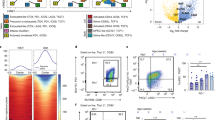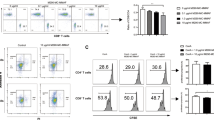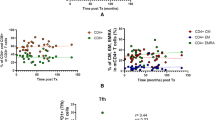Abstract
Cytolytic T lymphocyte–associated antigen 4 (CTLA-4) is a critical down-regulatory molecule in T cells that plays a major role in peripheral tolerance. Although the CD45 protein tyrosine phosphatase is a potent immunomodulatory target, the mechanisms by which antibody against CD45RB isoforms (anti-CD45RB) induces allograft tolerance remain unclear. We show here that anti-CD45RB treatment alters CD45 isoform expression on T cells, which is associated with rapid up-regulation of CTLA-4 expression. These effects appear specific and occur without up-regulation of other activation markers. Administration of a blocking monoclonal antibody to CTLA-4 at the time of transplantation prevents anti-CD45RB therapy from prolonging islet allograft survival. In addition, treatment with cyclosporin A blocks anti-CD45RB–induced CTLA-4 expression and promotes acute rejection. These data suggest that anti-CD45RB acts through mechanisms that include CTLA-4 up-regulation and demonstrate a link between CD45 and CTLA-4 that depends on calcineurin-mediated signaling. They demonstrate also that CTLA-4 expression may be specifically targeted to enhance allograft acceptance.
This is a preview of subscription content, access via your institution
Access options
Subscribe to this journal
Receive 12 print issues and online access
$209.00 per year
only $17.42 per issue
Buy this article
- Purchase on Springer Link
- Instant access to full article PDF
Prices may be subject to local taxes which are calculated during checkout





Similar content being viewed by others
References
Tivol, E. et al. Loss of CTLA-4 leads to massive lymphoproliferation and fatal multiorgan tissue destruction, revealing a critical negative regulatory role of CTLA-4. Immunity 3, 541–547 (1995).
Waterhouse P. et al. Lymphoproliferative disorders with early lethality in mice deficient in Ctla-4. Science 270, 985–988 (1995).
Perez, V. L. et al. Induction of peripheral T cell tolerance in vivo requires CTLA-4 engagement. Immunity 6, 411–417 (1997).
Leach, D. R., Krummel, M. F. & Allison, J. P. Enhancement of antitumor immunity by CTLA-4 blockade. Science 271, 1734–1736 (1996).
Luhder, F., Hoglund, P., Allison, J. P., Benoist, C. & Mathis, D. Cytotoxic T lymphocyte-associated antigen 4 (CTLA-4) regulates the unfolding of autoimmune diabetes. J. Exp. Med. 187, 427–432 (1998).
Karandikar, N. J., Vanderlugt, C. L., Walunas, T. L., Miller, S. D. & Bluestone, J. A. CTLA-4: a negative regulator of autoimmune disease. J. Exp. Med. 184, 783–788 (1996).
Takahashi, T. et al. Immunologic self-tolerance maintained by CD25(+)CD4(+) regulatory T cells constitutively expressing cytotoxic T lymphocyte-associated antigen 4. J. Exp. Med. 192, 303–310 (2000).
Judge, T. A. et al. The role of CD80, CD86, and CTLA4 in alloimmune responses and the induction of long-term allograft survival. J. Immunol. 162, 1947–1951 (1999).
Linsley, P. S. et al. Intracellular trafficking of CTLA-4 and focal localization towards sites of TCR engagement. Immunity 4, 535–543 (1996).
Alegre, M. L. et al. Regulation of surface and intracellular expression of CTLA4 on mouse T cells. J. Immunol. 157, 4762–4770 (1996).
Finn, P. W. et al. Synergistic induction of CTLA-4 expression by costimulation with TCR plus CD28 signals mediated by increased transcription and messenger ribonucleic acid stability. J. Immunol. 158, 4074–4081 (1997).
Krummel, M. F. & Allison, J. P. CD28 and CTLA-4 have opposing effects on the response of T cells to stimulation. J. Exp. Med. 182, 459–465 (1995).
Walunas, T. L. et al. CTLA-4 can function as a negative regulator of T cell activation. Immunity 1, 405–413 (1994).
Trowbridge, I. S. & Thomas, M. L. CD45: an emerging role as a protein tyrosine phosphatase required for lymphocyte activation and development. Ann. Rev. Immunol. 12, 85–116 (1994).
Kashio, N., Matsumoto, W., Parker, S. & Rothstein, D. M. The second domain of the CD45 transmembrane protein tyrosine phosphatase is critical for IL-2 secretion and for recruitment of substrates in vivo. J. Biol. Chem. 273, 33856–33863 (1998).
Bottomly, K. et al. A monoclonal antibody to murine CD45R distinguishes CD4 T cell populations that produce different cytokines. Eur. J. Immunol. 19, 617–623 (1989).
Lee, W., Yin, X.-M. & Vitetta, E. Functional and ontogenetic analysis of murine CD45hi and CD45lo CD4+ T cells. J. Immunol. 144, 3288–3295 (1990).
Powrie, F. et al. Inhibition of Th1 response prevents inflammatory bowel disease in scid mice reconstituted with CD45RBhi CD4+ T cells. Immunity 1, 553–562 (1994).
Morimoto, C., Letvin, N. L., Distaso, J. A., Aldrich. W. R. & Schlossman, S. F. The isolation and characterization of the human suppressor inducer T cell subset. J. Immunol. 134, 1508–1515 (1985).
Rothstein, D. M., Yamada, A., Schlossman, S. F. & Morimoto, C. Cyclic regulation of CD45 isoform expression in a long-term human CD4+CD45RA+ T cell line. J. Immunol. 146, 1175–1183 (1991).
Sparshott, S. & Bell, E. Membrane CD45R isoform exchange on CD4 T cells is rapid, frequent and dynamic in vivo. Eur. J .Immunol. 24, 2573–2578 (1994).
Michie, C. A., McLean, A., Alcock, C. & Beverley, P. C. L. Lifespan of human lymphocyte subsets defined by CD45 isoforms. Nature 360, 264–265 (1992).
McKenney, D. W., Onodera, H., Gorman, L., Mimura, T. & Rothstein, D. M. Individual isoforms of the CD45 protein tyrosine phosphatase differentially regulate IL-2 secretion and activation signal pathways involving Vav in T cells. J. Biol. Chem. 270, 24949–24954 (1995).
Onodera, H., Motto, D. G., Koretzky, G. A. & Rothstein, D. M. Differential regulation of activation-induced tyrosine phosphorylation and recruitment of SLP-76 to Vav by distinct isoforms of the CD45 protein tyrosine phosphatase. J. Biol. Chem. 271, 2225–2230 (1996).
Novak, T. et al. Isoforms of the transmembrane tyrosine phosphatase CD45 differentially affect T cell recognition. Immunity 1, 109–119 (1994).
Basadonna, G. et al. Antibody mediated targeting of CD45 isoforms: A novel immunotherapeutic strategy. Proc. Natl Acad. Sci. USA 95, 3821–3826 (1998).
Lazarovits, A. et al. Prevention and reversal of renal allograft rejection by antibody against CD45RB. Nature 380, 717–720 (1996).
Metz, D. P., Farber, D. L., Taylor, T. & Bottomly, K. Differential role of CTLA-4 in regulation of resting memory versus naïve CD4 T cell activation. J. Immunol. 161, 5855–5861 (1998).
Chuang, E. et al. Interaction of CTLA-4 with the clathrin-associated protein AP50 results in ligand-independent endocytosis that limits cell surface expression. J. Immunol. 159, 144–151 (1997).
Croft, M., Duncan, D. D. & Swain, S. L. Response of naïve antigen-specific CD4+ T cells in vitro: characteristics and antigen-presenting cell requirements. J. Exp. Med. 176, 1431–1437 (1992).
Liu, J. et al. Calcineurin is a common target of cyclophilin-cyclosporin A and FKBP-FK506 complexes. Cell 66, 807–815 (1991).
Walunas, T. L. & Bluestone, J. A. CTLA-4 regulates tolerance induction and T cell differentiation in vivo. J. Immunol. 160, 3855–3860 (1998).
Read, S., Malmstrom, V. & Powrie, F. Cytotoxic T lymphocyte-associated antigen 4 plays an essential role in the function of CD25(+)CD4(+) regulatory cells that control intestinal inflammation. J. Exp. Med. 192, 295–302 (2000).
Salomon, B. et al. B7/CD28 costimulation is essential for the homeostasis of the CD4+CD25+ immunoregulatory T cells that control autoimmune diabetes. Immunity 12, 431–440 (2000).
Perkins, D. et al. Regulation of CTLA-4 expression during T cell activation. J. Immunol. 156, 4154–4159 (1996).
Shiratori, T. et al. Tyrosine phosphorylation controls internalization of CTLA-4 by regulating its interaction with clathrin-associated adaptor complex AP-2. Immunity 6, 583–589 (1997).
Schneider, H. et al. Cytolytic T lymphocyte-associated antigen-4 and the TCR ζ/CD3 complex, but not CD28, interact with clathrin adaptor complexes AP-1 and AP-2. J. Immunol. 163, 1868–1879 (1999).
Rothstein, D. M., Saito, H., Streuli, M., Schlossman, S. F. & Morimoto, C. The alternative splicing of the CD45 tyrosine phosphatase is controlled by negative regulatory trans-acting splicing factors. J. Biol. Chem. 267, 7139–7147 (1992).
Tedder, T. F., Clement, L. T. & Cooper, M. D. Human lymphocyte differentiation antigens HB-10 and HB-11 I. Ontogeny of antigen expression. J. Immunol. 134, 2983–2988 (1985).
Bell, E. B. & Sparshott, S. M. Interconversion of CD45R subsets of CD4 T cell in vivo. Nature 348, 163–166 (1990).
Leitenberg, D., Novak, T., Farber, D. L., Smith, B. R. & Bottomly, K. The extracellular domain of CD45 controls association with the CD4/T cell receptor complex and the response to antigen specific stimulation. J. Exp. Med. 183, 249–259 (1996).
Leitenberg, D., Constant, S., Lu, D. D., Smith, B. R. & Bottomly, K. CD4 and CD45 regulate qualitatively distinct patterns of calcium mobilization in individual CD4+ T cells. Eur. J .Immunol. 25, 2445–2451 (1995).
Desai, D., Sap, J., Schlessinger, J. & Weiss, A. Ligand-mediated negative regulation of a chimeric transmembrane receptor tyrosine phosphatase. Cell 73, 541–554 (1993).
Li, Y. et al. Blocking both signal 1 and signal 2 of T-cell activation prevents apoptosis of alloreactive T cells and induction of peripheral allograft tolerance. Nature Med. 5, 1298–1302 (1999).
Acknowledgements
Supported in part by the NIH (grants AI-36317 and AI-45485 to D. M. R. and AI-41521 to M. H. S.) and the Juvenile Diabetes Foundation International (G. P. B. and S. F.). We thank J. Allison for the gift of reagents and K. Bottomly, D. Metz, J. Madreans and Z. Yin for helpful discussions.
Author information
Authors and Affiliations
Corresponding author
Rights and permissions
About this article
Cite this article
Fecteau, S., Basadonna, G., Freitas, A. et al. CTLA-4 up-regulation plays a role in tolerance mediated by CD45. Nat Immunol 2, 58–63 (2001). https://doi.org/10.1038/83175
Received:
Accepted:
Issue Date:
DOI: https://doi.org/10.1038/83175
This article is cited by
-
Anti‐CD45RB and donor‐specific spleen cells transfusion inhibition allograft skin rejection mediated by memory T cells
Immunology & Cell Biology (2017)
-
The roles of IL-2 and IL-10 enhance anti-CD45RBmAb immune inhibition in allograft skin
Immunologic Research (2015)



